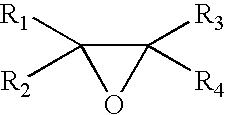Curable Composition and Elastic Roller Therefrom
- Summary
- Abstract
- Description
- Claims
- Application Information
AI Technical Summary
Benefits of technology
Problems solved by technology
Method used
Image
Examples
example 1
[0048] A mixture was prepared by kneading 500 g of allyl-terminated polyoxypropylene (product name: ACX004-N, manufactured by Kaneka Corporation; corresponding to component A) with 70 g of Carbon Black #3030B (manufactured by Mitsubishi Chemical Corporation; corresponding to component F) using a 3-roll mill. Then, 16 g of polyorganohydrogensiloxane (product name: CR100, manufactured by Kaneka Corporation; corresponding to component B), 350 μL of a bis(1,3-divinyl-1,1,3,3-tetramethyldisiloxane)-platinum complex catalyst (platinum content 3% by weight, xylene solution; corresponding to component C), 170 μL of dimethyl maleate-and 5 g of tetraethoxysilane (corresponding to component D) were uniformly admixed with the mixture mentioned above. The resulting curable composition was debubbled using a vacuum debubbling agitator (manufactured by Sea-tec Co., Ltd.) for 90 minutes. This curable composition was injected into a mold (inside diameter 16 mm) with a SUS stainless steel shaft having...
example 2
[0049] A mixture was prepared by kneading 500 g of allyl-terminated polyoxypropylene (product name: ACX004-N, manufactured by Kaneka Corporation; corresponding to component A) with 70 g of #3030B (manufactured by Mitsubishi Chemical Corporation; corresponding to component F) using a 3-roll mill. Then, 16 g of polyorganohydrogensiloxane (product name: CR100, manufactured by Kaneka Corporation; corresponding to component B), 350 μL of a bis(1,3-divinyl-1,1,3,3-tetramethyldisiloxane)-platinum complex catalyst (platinum content 3% by weight, xylene solution; corresponding to component C), 170 μL of dimethyl maleate and 5 g of acetoalkoxyaluminum diisopropylate (product name: AL-M, manufactured by Ajinomoto Fine-Techno. Co. Inc; corresponding to component D) were uniformly admixed with the mixture mentioned above. An elastic layer roller was manufactured in the same manner as in Example 1 and tested for ASKER-C hardness and, after roller covering layer formation in the same manner as in ...
example 3
[0050] A mixture was prepared by kneading 500 g of allyl-terminated polyoxypropylene (product name: ACX004-N, manufactured by Kaneka Corporation; corresponding to component A) with 70 g of #3030B (manufactured by Mitsubishi Chemical Corporation; corresponding to component F) using a 3-roll mill. Then, 16 g of polyorganohydrogensiloxane (product name: CR100, manufactured by Kaneka Corporation; corresponding to component B), 350 μL of a bis(1,3-divinyl-1,1,3,3-tetramethyldisiloxane)-platinum complex catalyst (platinum content 3% by weight, xylene solution; corresponding to component C), 170 μL of dimethyl maleate and 5 g of tetrabutoxytitanium (corresponding to component D) were uniformly admixed with the mixture mentioned above. An elastic layer roller was manufactured in the same manner as in Example 1 and tested for ASKER-C hardness and, after roller covering layer formation in the same manner as in Example 1, the roller was tested for interfacial peeling between the elastic layer ...
PUM
| Property | Measurement | Unit |
|---|---|---|
| Angle | aaaaa | aaaaa |
| Electrical conductivity | aaaaa | aaaaa |
| Composition | aaaaa | aaaaa |
Abstract
Description
Claims
Application Information
 Login to View More
Login to View More - Generate Ideas
- Intellectual Property
- Life Sciences
- Materials
- Tech Scout
- Unparalleled Data Quality
- Higher Quality Content
- 60% Fewer Hallucinations
Browse by: Latest US Patents, China's latest patents, Technical Efficacy Thesaurus, Application Domain, Technology Topic, Popular Technical Reports.
© 2025 PatSnap. All rights reserved.Legal|Privacy policy|Modern Slavery Act Transparency Statement|Sitemap|About US| Contact US: help@patsnap.com

